以太坊 Merkle Patricia Trie 是如何工作的
- aisiji
- 发布于 2021-06-28 10:56
- 阅读 6522
解释 Merkle Patricia Trie 究竟是如何工作的,并展示一个 Merkle 证明生成和验证的demo。
介绍
Merkle Patricia Trie 是以太坊存储层的关键数据结构之一。我希望了解它到底是如何工作的,于是遍寻资料进行了深入研究,实现了这个算法。
在这篇博文里,我将分享我所学到的东西。解释 Merkle Patricia Trie 究竟是如何工作的,并展示一个 Merkle 证明生成和验证的demo。
算法的源代码和本博文中使用的例子都是开源的: https://github.com/zhangchiqing/merkle-patricia-trie
好了,我们开始吧。
一个基本的键-值映射
以太坊的 Merkle Patricia Trie 本质上是一种键值映射,它提供以下标准方法。
type Trie interface {
// methods as a basic key-value mapping
Get(key []byte) ([]byte, bool) {
Put(key []byte, value []byte)
Del(key []byte, value []byte) bool
}上述 Trie 接口的实现应该通过以下测试案例。
func TestGetPut(t *testing.T) {
t.Run("should get nothing if key does not exist", func(t *testing.T) {
trie := NewTrie()
_, found := trie.Get([]byte("notexist"))
require.Equal(t, false, found)
})
t.Run("should get value if key exist", func(t *testing.T) {
trie := NewTrie()
trie.Put([]byte{1, 2, 3, 4}, []byte("hello"))
val, found := trie.Get([]byte{1, 2, 3, 4})
require.Equal(t, true, found)
require.Equal(t, val, []byte("hello"))
})
t.Run("should get updated value", func(t *testing.T) {
trie := NewTrie()
trie.Put([]byte{1, 2, 3, 4}, []byte("hello"))
trie.Put([]byte{1, 2, 3, 4}, []byte("world"))
val, found := trie.Get([]byte{1, 2, 3, 4})
require.Equal(t, true, found)
require.Equal(t, val, []byte("world"))
})
}(本教程中的测试案例在代码库并已经通过了。)
验证数据的完整性
Merkle patricia trie 与标准映射有什么不同?
Merkle patricia trie 允许我们验证数据的完整性(在本文的其余部分,为了简单起见,我们将称它为trie。)
我们可以用Hash函数计算 trie 的 Merkle root Hash ,如果任何键值对被更新,trie 的Merkle root Hash 就会不同;如果两个 Trie 有相同的键值对,它们应该有相同的 Merkle root Hash。
type Trie interface {
// compute the merkle root hash for verifying data integrity
Hash() []byte
}让我们用一些测试案例来解释这种行为。
// 验证数据的完整性
func TestDataIntegrity(t *testing.T) {
t.Run("should get a different hash if a new key-value pair was added or updated", func(t *testing.T) {
trie := NewTrie()
hash0 := trie.Hash()
trie.Put([]byte{1, 2, 3, 4}, []byte("hello"))
hash1 := trie.Hash()
trie.Put([]byte{1, 2}, []byte("world"))
hash2 := trie.Hash()
trie.Put([]byte{1, 2}, []byte("trie"))
hash3 := trie.Hash()
require.NotEqual(t, hash0, hash1)
require.NotEqual(t, hash1, hash2)
require.NotEqual(t, hash2, hash3)
})
t.Run("should get the same hash if two tries have the identicial key-value pairs", func(t *testing.T) {
trie1 := NewTrie()
trie1.Put([]byte{1, 2, 3, 4}, []byte("hello"))
trie1.Put([]byte{1, 2}, []byte("world"))
trie2 := NewTrie()
trie2.Put([]byte{1, 2, 3, 4}, []byte("hello"))
trie2.Put([]byte{1, 2}, []byte("world"))
require.Equal(t, trie1.Hash(), trie2.Hash())
})
}验证是否包含一个键值对
trie 可以验证数据的完整性,但为什么不简单地通过散列整个键值对列表来比较散列,为什么要费力地创建一个 trie 数据结构?
这是因为 trie 还允许我们在不访问整个键值对的情况下验证键值对的包含情况。
这意味着 trie 可以提供一个证明,以证明某个键值对包含在产生某个 merkle 根散列的键值映射中。
type Proof interface {}
type Trie interface {
// generate a merkle proof for a key-value pair for verifying the inclusion of the key-value pair
Prove(key []byte) (Proof, bool)
}
// verify the proof for the given key with the given merkle root hash
func VerifyProof(rootHash []byte, key []byte, proof Proof) (value []byte, err error)这在以太坊中是很有用的。例如,设想以太坊的世界状态是一个键值映射,键是每个账户地址,值是每个账户的余额。
作为一个轻客户端,它不像全节点那样可以访问完整的区块链状态,而只是访问某些区块的 Merkle 根哈希值,它怎么能相信全节点返回的账户余额结果?
答案是,一个完整的节点可以提供一个 merkle 证明,其中包含 merkle 根哈希值、账户密钥及其余额值,以及其他数据。这个 merkle 证明允许轻客户通过自己的方式验证正确性,而不需要访问完整的区块链状态。
让我们用测试案例来解释这种行为。
func TestProveAndVerifyProof(t *testing.T) {
t.Run("should not generate proof for non-exist key", func(t *testing.T) {
tr := NewTrie()
tr.Put([]byte{1, 2, 3}, []byte("hello"))
tr.Put([]byte{1, 2, 3, 4, 5}, []byte("world"))
notExistKey := []byte{1, 2, 3, 4}
_, ok := tr.Prove(notExistKey)
require.False(t, ok)
})
t.Run("should generate a proof for an existing key, the proof can be verified with the merkle root hash", func(t *testing.T) {
tr := NewTrie()
tr.Put([]byte{1, 2, 3}, []byte("hello"))
tr.Put([]byte{1, 2, 3, 4, 5}, []byte("world"))
key := []byte{1, 2, 3}
proof, ok := tr.Prove(key)
require.True(t, ok)
rootHash := tr.Hash()
// verify the proof with the root hash, the key in question and its proof
val, err := VerifyProof(rootHash, key, proof)
require.NoError(t, err)
// when the verification has passed, it should return the correct value for the key
require.Equal(t, []byte("hello"), val)
})
t.Run("should fail the verification if the trie was updated", func(t *testing.T) {
tr := NewTrie()
tr.Put([]byte{1, 2, 3}, []byte("hello"))
tr.Put([]byte{1, 2, 3, 4, 5}, []byte("world"))
// the hash was taken before the trie was updated
rootHash := tr.Hash()
// the proof was generated after the trie was updated
tr.Put([]byte{5, 6, 7}, []byte("trie"))
key := []byte{1, 2, 3}
proof, ok := tr.Prove(key)
require.True(t, ok)
// should fail the verification since the merkle root hash doesn't match
_, err := VerifyProof(rootHash, key, proof)
require.Error(t, err)
})
}一个轻量级的客户可以要求得到一个 trie 状态的 merkle root hash,并使用它来验证其账户的余额。如果 trie 被更新了,即使更新的是其他键,验证也会失败。
而现在,轻客户只需要相信 Merkle 根的哈希值,这一小段数据,就可以确定全节点是否为其账户返回了正确的余额。
好吧,但为什么轻客户端要相信 Merkle 根哈希值呢?
由于以太坊的共识机制是工作证明,而世界状态的 merkle 根哈希值包含在每个区块头中,所以计算工作是验证/信任 merkle 根哈希值的证明。
一个小小的 Merkle 根的哈希值可以用来验证一个巨大的键值映射的状态,这非常酷。
验证实现
我已经解释了 merkle patricia trie 的工作原理。代码库提供了一个简单的实现。但是,怎样才能验证我们的实现呢?
一个简单的方法是用以太坊主网数据和 Trie golang 的官方实现来验证。
以太坊有3个 Merkle Patricia Trie:Transaction Trie 、Receipt Trie 和 State Trie。在每个区块头中,它包括3个 Merkle 根哈希值:transactionRoot, receiptRoot和stateRoot。
由于 transactionRoot 是区块中所有交易的 Merkle 根哈希值,可以通过获取所有交易来验证我们的实现,然后将它们存储在我们的 trie 中,计算其 Merkle 根哈希值,最后与区块头中的 transactionRoot 进行比较。
例如,我挑选了主网10467135区块,并将所有193个交易保存到transactions.json文件中。
由于块10467135的交易根是[0xbb345e208bda953c908027a45aa443d6cab6b8d2fd64e83ec52f1008ddeafa58](https://api.etherscan.io/api?module=proxy&action=eth_getBlockByNumber&tag=0x9fb73f&boolean=true&apikey=YourApiKeyToken)。我可以创建一个测试案例,将10467135区块的193个交易添加到我们的Trie中并进行检查。
- merkle 根哈希值是否为
bb345e208bda953c908027a45aa443d6cab6b8d2fd64e83ec52f1008ddeafa58。 - 从我们的 trie 实现中产生的某个交易的 merkle 证明是否能被官方实现所验证。
但交易列表的键和值是什么?键是无符号整数的 RLP 编码,从索引0开始;值是相应交易的 RLP 编码。
好的,让我们看看测试案例:
import (
"github.com/ethereum/go-ethereum/common"
"github.com/ethereum/go-ethereum/core/types"
"github.com/ethereum/go-ethereum/trie"
)
// use the official golang implementation to check if a valid proof from our implementation can be accepted
func VerifyProof(rootHash []byte, key []byte, proof Proof) (value []byte, err error) {
return trie.VerifyProof(common.BytesToHash(rootHash), key, proof)
}
// load transaction from json
func TransactionJSON(t *testing.T) *types.Transaction {
jsonFile, err := os.Open("transaction.json")
defer jsonFile.Close()
require.NoError(t, err)
byteValue, err := ioutil.ReadAll(jsonFile)
require.NoError(t, err)
var tx types.Transaction
json.Unmarshal(byteValue, &tx)
return &tx
}
func TestTransactionRootAndProof(t *testing.T) {
trie := NewTrie()
txs := TransactionsJSON(t)
for i, tx := range txs {
// key is the encoding of the index as the unsigned integer type
key, err := rlp.EncodeToBytes(uint(i))
require.NoError(t, err)
transaction := FromEthTransaction(tx)
// value is the RLP encoding of a transaction
rlp, err := transaction.GetRLP()
require.NoError(t, err)
trie.Put(key, rlp)
}
// the transaction root for block 10467135
// https://api.etherscan.io/api?module=proxy&action=eth_getBlockByNumber&tag=0x9fb73f&boolean=true&apikey=YourApiKeyToken
transactionRoot, err := hex.DecodeString("bb345e208bda953c908027a45aa443d6cab6b8d2fd64e83ec52f1008ddeafa58")
require.NoError(t, err)
t.Run("merkle root hash should match with 10467135's transactionRoot", func(t *testing.T) {
// transaction root should match with block 10467135's transactionRoot
require.Equal(t, transactionRoot, trie.Hash())
})
t.Run("a merkle proof for a certain transaction can be verified by the offical trie implementation", func(t *testing.T) {
key, err := rlp.EncodeToBytes(uint(30))
require.NoError(t, err)
proof, found := trie.Prove(key)
require.Equal(t, true, found)
txRLP, err := VerifyProof(transactionRoot, key, proof)
require.NoError(t, err)
// verify that if the verification passes, it returns the RLP encoded transaction
rlp, err := FromEthTransaction(txs[30]).GetRLP()
require.NoError(t, err)
require.Equal(t, rlp, txRLP)
})
}上述测试案例通过了,并且表明如果我们将10467135区块的所有193个交易加入到 trie 中,那么 trie 的哈希值与该区块中公布的 transactionRoot 相同。而由我们的 trie 生成的索引为30的交易的 merkle 证明,被官方的 golang trie 认为是有效的实现。
深入 Merkle Patricia Trie - Trie 节点
现在,让我们来看看Trie的内部实现。
在内部,trie 有4种类型的节点。空节点(EmptyNode)、叶节点(LeafNode)、分支节点(BranchNode)和扩展节点(ExtensionNode)。每个节点将被编码并作为键值对存储在键值存储中。
让我们以主网的区块10593417为例,来说明一个Transaction Trie是如何建立的,以及它是如何存储的。
Block 10593417只有4个 Root hash 交易。0xab41f886be23cd786d8a69a72b0f988ea72e0b2e03970d0798f5e03763a442cc.因此,为了将4个交易存储到一个 trie ,我们实际上是以十六进制字符串的形式存储以下键值对。
(80, f8ab81a5852e90edd00083012bc294a3bed4e1c75d00fa6f4e5e6922db7261b5e9acd280b844a9059cbb0000000000000000000000008bda8b9823b8490e8cf220dc7b91d97da1c54e250000000000000000000000000000000000000000000000056bc75e2d6310000026a06c89b57113cf7da8aed7911310e03d49be5e40de0bd73af4c9c54726c478691ba056223f039fab98d47c71f84190cf285ce8fc7d9181d6769387e5efd0a970e2e9)
(01, f8ab81a6852e90edd00083012bc294a3bed4e1c75d00fa6f4e5e6922db7261b5e9acd280b844a9059cbb0000000000000000000000008bda8b9823b8490e8cf220dc7b91d97da1c54e250000000000000000000000000000000000000000000000056bc75e2d6310000026a0d77c66153a661ecc986611dffda129e14528435ed3fd244c3afb0d434e9fd1c1a05ab202908bf6cbc9f57c595e6ef3229bce80a15cdf67487873e57cc7f5ad7c8a)
(02, f86d8229f185199c82cc008252089488e9a2d38e66057e18545ce03b3ae9ce4fc360538702ce7de1537c008025a096e7a1d9683b205f697b4073a3e2f0d0ad42e708f03e899c61ed6a894a7f916aa05da238fbb96d41a4b5ec0338c86cfcb627d0aa8e556f21528e62f31c32f7e672)
(03, f86f826b2585199c82cc0083015f9094e955ede0a3dbf651e2891356ecd0509c1edb8d9c8801051fdc4efdc0008025a02190f26e70a82d7f66354a13cda79b6af1aa808db768a787aeb348d425d7d0b3a06a82bd0518bc9b69dc551e20d772a1b06222edfc5d39b6973e4f4dc46ed8b196)80是无符号整数0的 RLP 编码结果的十六进制形式:RLP(uint(0))。01是RLP(uint(1))的结果,以此类推。
密钥80的值是第一个交易的 RLP 编码的结果。键值01是第二个交易的值,以此类推。
因此,我们将把上述4个键值对添加到trie中,让我们看看添加每一个键值对时,trie的内部结构如何变化。
为了更直观,我将用一些图来解释它的工作原理。你也可以通过在测试案例中添加日志来检查每一步的状态。
Empty Trie
trie 结构只包含一个根字段,指向一个根节点。而节点类型是一个接口,它可以是4种类型的节点之一。
type Trie struct {
root Node
}当一个 trie 被创建时,根节点指向一个 EmptyNode。

添加第一笔交易
当添加第一个交易的键值对时,一个叶节点(LeafNode)被创建,交易数据存储在其中。根节点被更新以指向该叶节点(LeafNode)。

添加第二笔交易
当添加第2个交易时,根部的叶节点(LeafNode) 将变成一个分支节点(BranchNode),有两个分支指向2个叶节点(LeafNode) 。左边的叶节点(LeafNode) 持有剩余的 nibbles(nibbles是一个单一的十六进制字符)-1,以及第2个交易的值。
而现在根节点正指向新的分支节点(BranchNode)。
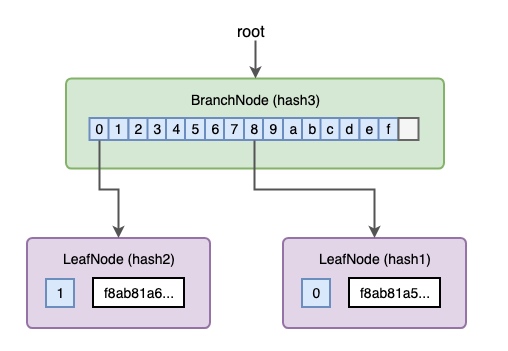
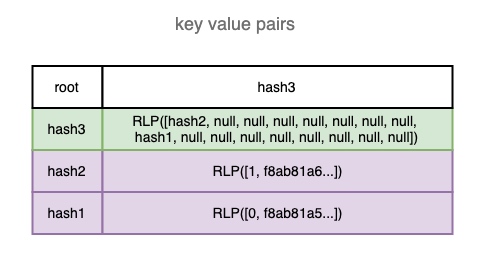
添加第三笔交易
添加第3个交易将使左侧的叶节点(LeafNode) 变成一个分支节点(BranchNode) ,与添加第2个交易的过程类似。虽然根节点没有改变,但它的根哈希值已经改变了,因为它的0分支指向了不同的节点,有不同的哈希值。
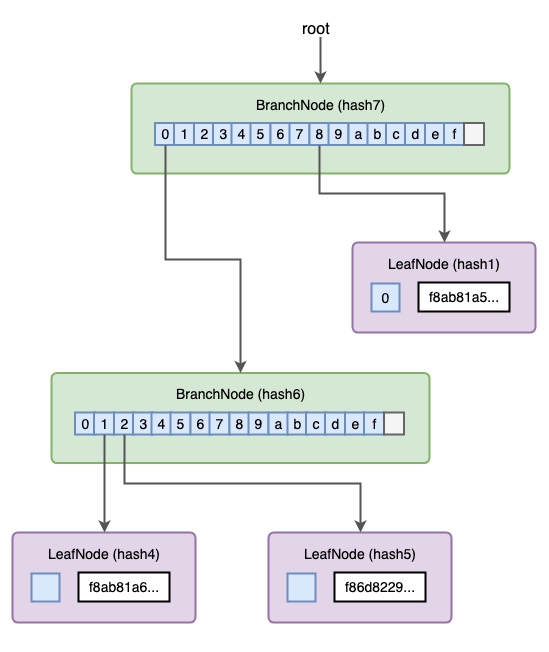
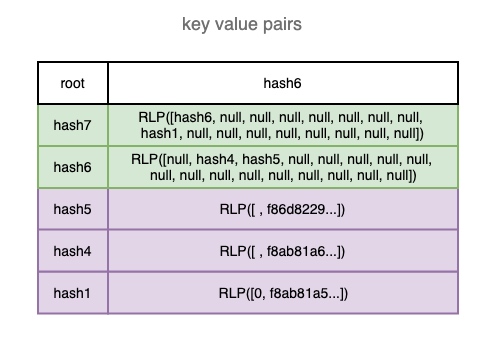
添加第四笔交易
添加最后一个交易与添加第三个交易类似。现在我们可以验证根哈希值是否与区块中包含的 transactionRoot 相同。
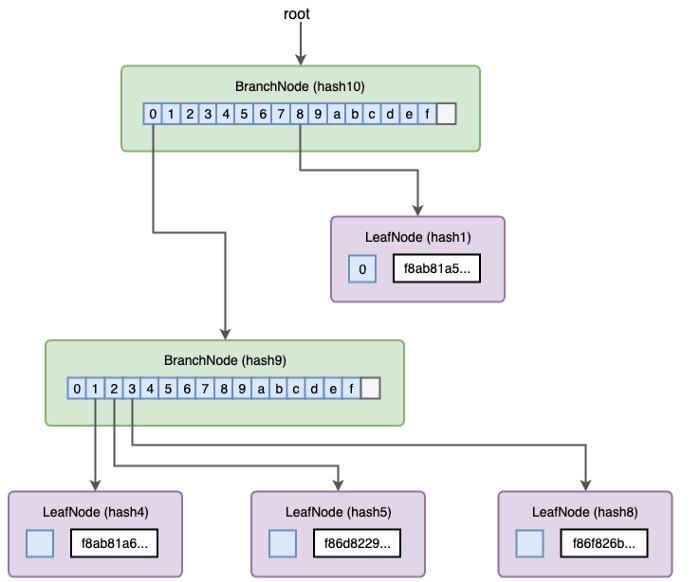
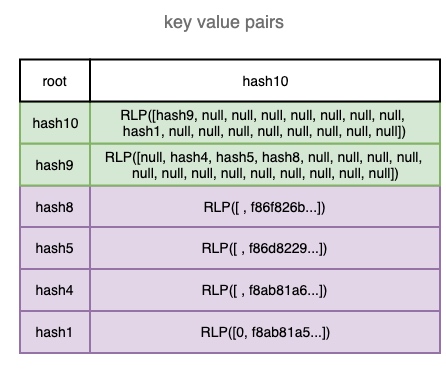
获得第三笔交易的默克尔证明
第3笔交易的 Merkle 证明只是通往存储第3笔交易值的叶节点(LeafNode) 的路径。在验证证明时,可以从根哈希值开始,解码 Node,匹配 nibbles ,然后重复,直到找到匹配所有剩余 nibbles 的 Node。如果找到了,那么这个值就是与密钥配对的那个值;如果没有找到,那么 Merkle 证明就无效了。
更新 trie 的规则
在上面的例子中,我们已经建立了一个有3种类型节点的trie。空节点、叶节点和分支节点。然而,我们没有机会使用扩展节点(ExtensionNode) 。请找到其他使用 ExtensionNode 的测试案例。
一般来说,该规则是:
- 当停在一个空节点时,用一个新的叶子节点替换它的剩余路径。
- 当停在一个叶节点(LeafNode) 时,将其转换为一个 ExtensionNode 并添加一个新的分支和一个新的叶节点(LeafNode) 。
- 当停在一个扩展节点时,将其转换为另一个具有较短路径的扩展节点,并创建一个新的分支节点指向该扩展节点。
有相当多的细节,如果你有兴趣,你可以阅读源代码。
摘要
Merkle Patricia Trie 是一个存储键值对的数据结构,就像一个地图。除此之外,它还允许我们验证数据的完整性和键值对的包容性。
本翻译由 Cell Network 赞助支持。
- 结合预确认与Based Rollup的架构,实现同步可组合性 45 浏览
- 区块链101:区块链的演进 63 浏览
- Fusaka:更多 Blob,更少投票,伤心欲绝? 86 浏览
- op succint(op Kailua等riscv通用零知识证明虚拟机)和zkysnc等专用零知识证明的在以太坊上面的核心区别 74 浏览
- 区块链 101:数据处理 223 浏览
- Fusaka对智能合约安全的影响 85 浏览
- 为什么许多团队的Layer 2迁移会失败(以及如何正确地进行迁移) 210 浏览
- 2644 万美元被盗:Truebit 协议智能合约漏洞分析 174 浏览
- 臭名昭著的漏洞文摘#6:Balancer的支线故事与Rust的特定问题 325 浏览
- 我们的 2026 年路线图 401 浏览
- 深入分析:Truebit 事件博客 126 浏览
- 基于哈希函数的签名(四):XMSS 和 SPHINCS 267 浏览

